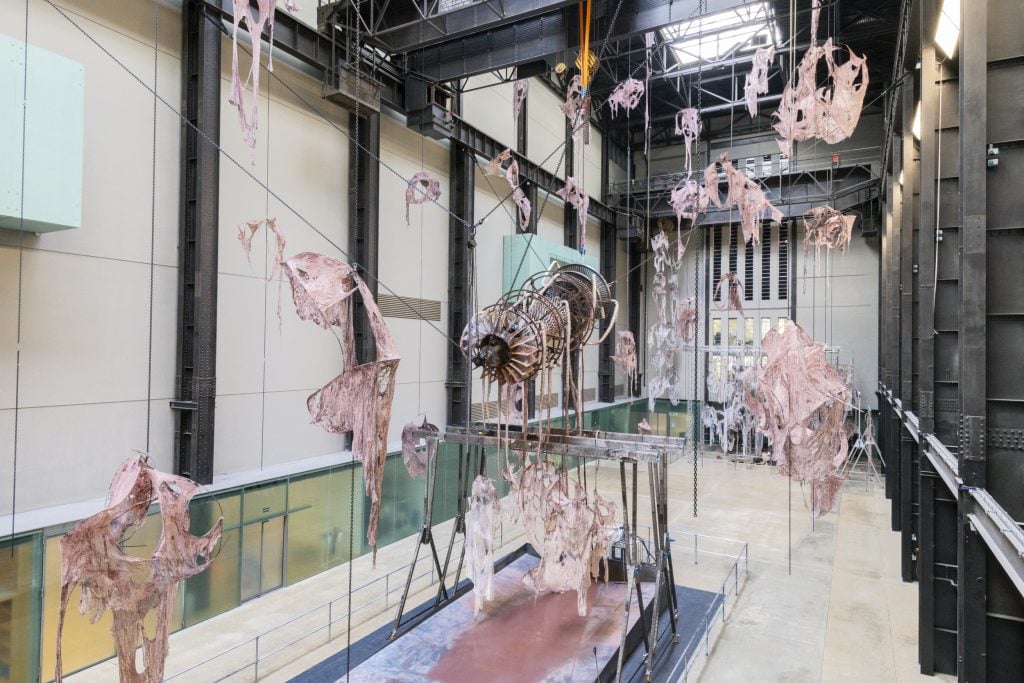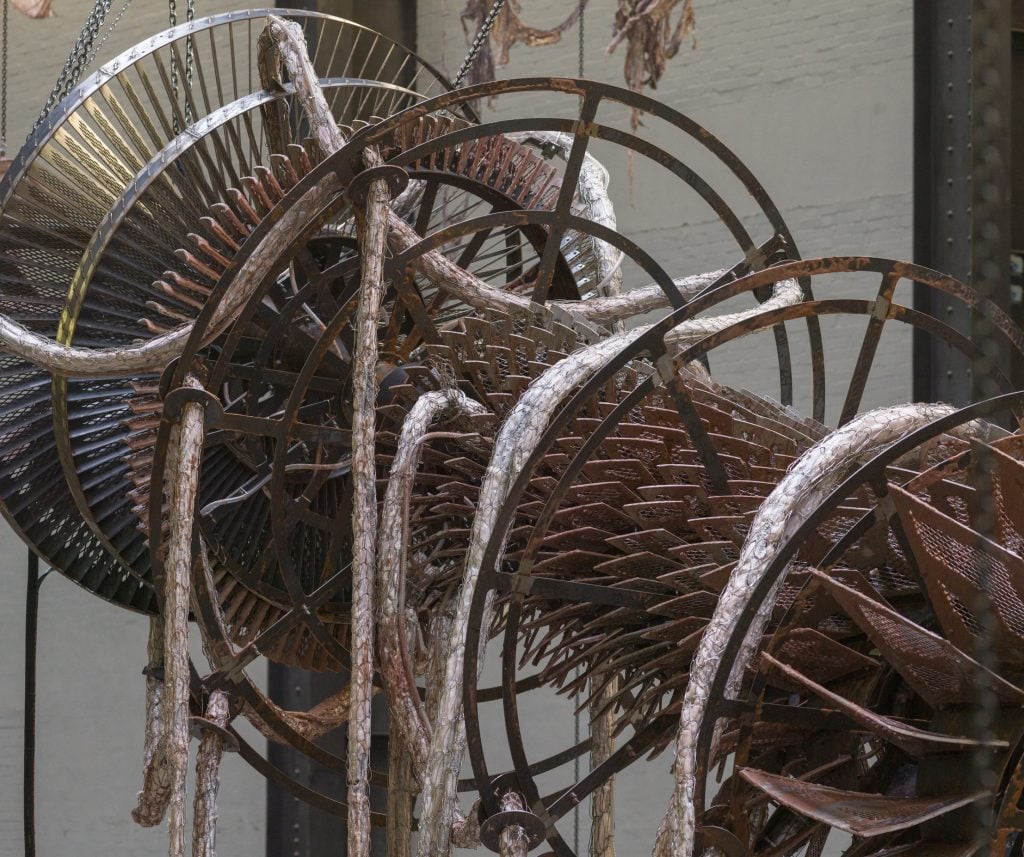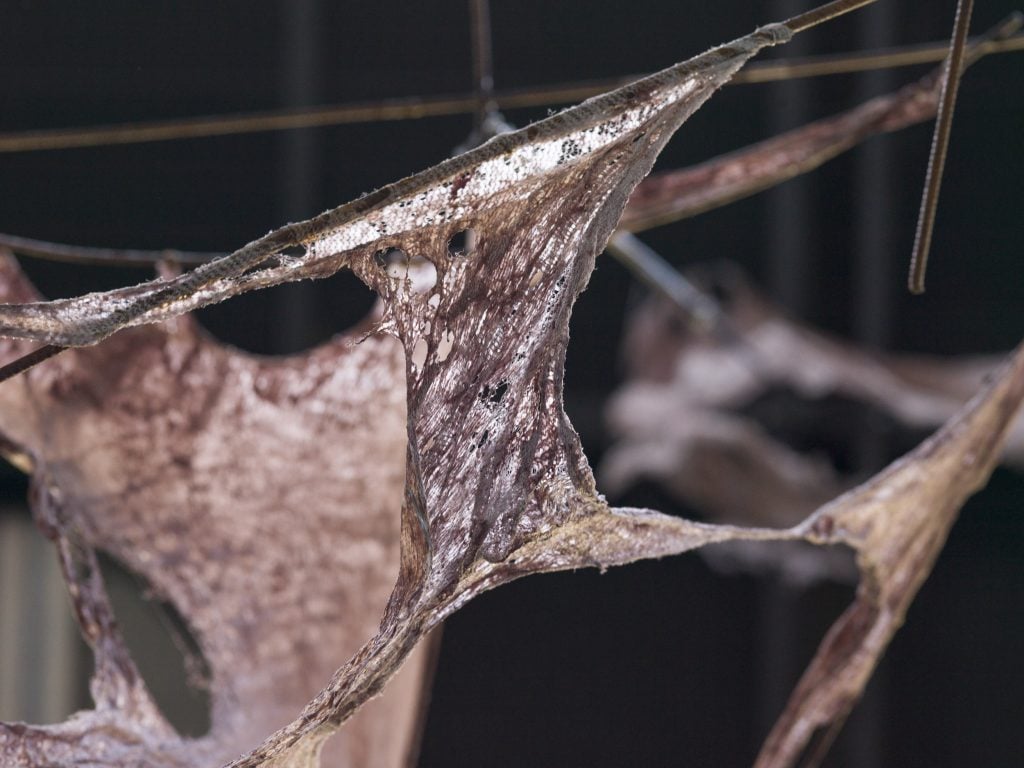Museums & Institutions
Mire Lee’s Massive New Work in Tate’s Turbine Hall Provokes Awe and Disgust
The Korean artist's bodily machines riff on the building's original purpose as a power station.

The Korean artist's bodily machines riff on the building's original purpose as a power station.

Jo Lawson-Tancred

If El Anatsui’s cascading monuments made of bottle caps, which filled Tate Modern’s Turbine Hall last October, were awe-inspiring, this year’s commission could best be described as eww-inspiring. Unveiled today, the museum’s vast hangar-like entrance has been taken over by Open Wound, Korean artist Mire Lee’s intentionally confronting, proudly grotesque installation centered around a slowly whirring turbine. It riffs, of course, on the building’s original purpose as a power station once filled with coal and oil-fired turbines.
The seemingly makeshift machine is draped in silicone tubes dripping a murky pink liquid that pools onto a tray underneath. On its descent, some of this fluid is absorbed by suspended scraps of torn construction mesh stretched over bent metal hangers, remnants of industry that, in this context, become more like organic viscera.
Eventually, these tainted and tattered sculptures, which Lee calls “skins,” are dried out by a team of technicians and hoisted up on chains so that they float down from the ceiling. This routine performance aspect recalls a factory assembly line. By the end of the show’s run on March 16, 2025, the hanging skins will have multiplied many times over, as though the building is in some way “shedding” organic matter.

Hyundai Commission: Mire Lee: Open Wound installed in the Turbine Hall at Tate Modern, 2024. Photo: Oliver Cowling with Lucy Green, © Tate.
Born in Seoul and based in Amsterdam, Lee has built a cult following for audacious works that toy with her audience, producing in us a bewildering yet bizarrely captivating mix of attraction and disgust. This is because her kinetic installations blur the boundary between rote, creaking mechanical systems and the body: soft, sloppy, and prone to decompose. The result is unsettlingly intimate and exposing.
Among Lee’s standout institutional outings was her inclusion in “The Milk of Dreams,” the main exhibition at the 59th Venice Biennale in 2022, followed by a solo show at the New Museum in New York last year. At the Busan Biennale in 2022, she showed off her ability to work at considerable scale, filling an abandoned building with scaffolding over which she stretches great swatches of torn fabric.
Now in her mid-30s, Lee is the youngest artist ever to be tapped for the Tate’s Turbine Hall commission. Speaking at a press conference this morning she said that when she first visited the space she was struck by its height and length. “I thought it could be like an animal body,” she said. For an artist so entranced by machinery, the building’s industrial history was an obvious invitation. “I somehow wanted to activate it again.”

Hyundai Commission: Mire Lee: Open Wound installed in the Turbine Hall at Tate Modern, 2024. Photo: Oliver Cowling with Lucy Green, © Tate.
One of her principal references was the pulley system installed in the changing rooms used by coal miners, so that they could store baskets of clothes up by the ceiling. Lee saw it as an inventive way to make use of the available space. “I wanted to find a way to fill the space but also make it look not filled,” she said, never one to shy from contradiction.
“Skins are the last layer that divide you from the world,” Lee added. The idea of an “open wound” could refer to an artist’s wound, or “how the artist wants to change the world with art but they cannot. The wound stays open, it never closes. But it’s better to have the wound open than have nothing.”
The annual Turbine Hall commission is an important showcase for an international artist at the top of their game, inviting them to work at a scale that cannot usually be accommodated in an institutional setting. Previous artists to take part have included El Anatsui (2023), Kara Walker (2019), Ai Weiwei (2011), Bruce Nauman (2005), Olafur Eliasson (2004), and Louise Bourgeois (2000).
“Hyundai Commission: Mire Lee: Open Wound” is on view until May 16, 2025 at Tate Modern, London.